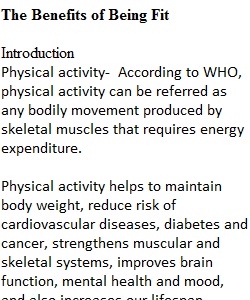


Q Scenario: Prior to starting work on this assignment, please review all required resources in this week, if you have not done so already. Since you have a health and wellness background, your supervisor asks you to give a presentation at the local library for a small group of community members. Select one of the following audiences to use for this project: elderly, youth, diabetics, obese, or individuals with cardiovascular disease. The members of your group do not exercise currently, and they are hesitant to do so. Therefore, your presentation on the benefits of personal fitness must be convincing. Within your presentation, you must Explain what physical activity entails and examine its relationship to fitness and wellness. Describe your chosen group. How many Americans are inactive, and what are the health consequences of physical inactivity? Utilize and cite relevant statistics to support your claims and findings. Describe the benefits of a regular exercise routine. Appraise the relationship and benefits of cardiorespiratory endurance training, muscular strength and endurance training, flexibility, and body composition and the factors affecting these components. Explain how every member of your audience can assess his/her fitness status pertaining to each health-related fitness component. For instance, one can use the BMI to assess body composition. Develop at least three specific exercise recommendations that could be incorporated into your selected group’s daily routine, and include how your recommendations address each of the components (from above) of health-related fitness. Provide at least three tips on exercising safely (e.g., environmental conditions, fluid intake, injury prevention). Examine exercise behavior and physical activity habits as well as common barriers and/or challenges to fitness. Offer sound tips on how these challenges and barriers can be overcome. Examine three local facilities that offer fitness programs tailored to your chosen group. Briefly describe each facility (i.e., amenities, equipment, access, membership, location, programs/services offered, program days and times, cost). Out of these three programs, include one that is free of charge. Free offerings may be available through local parks, churches, hospitals, non-profit organizations, schools, universities, or libraries. Organize this information in a way that is easy for your audience to review.
View Related Questions